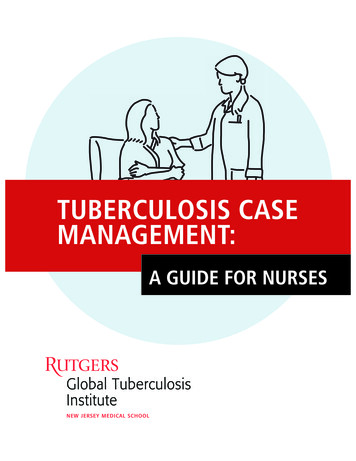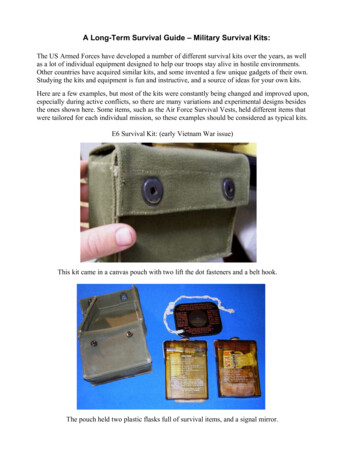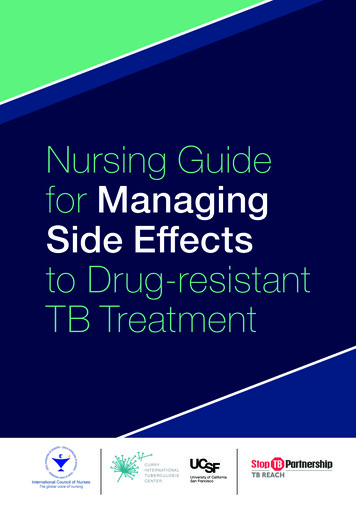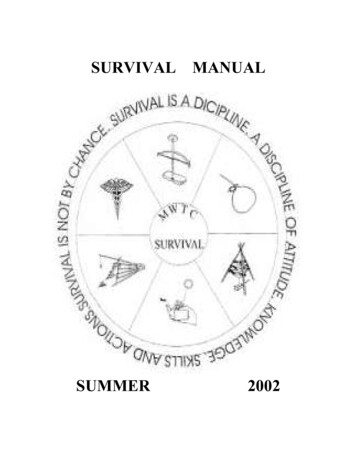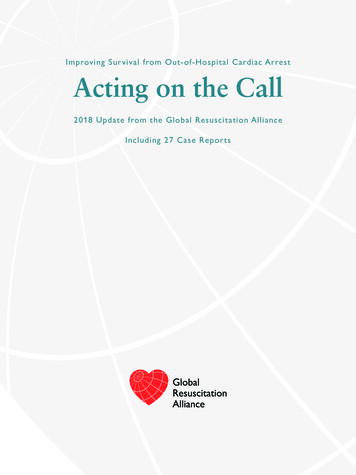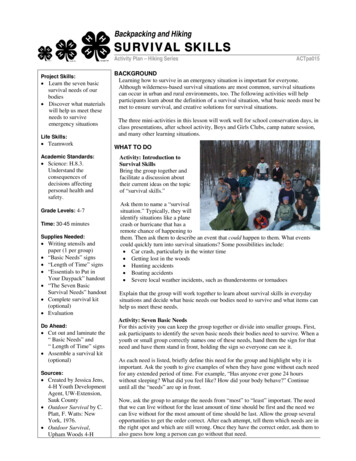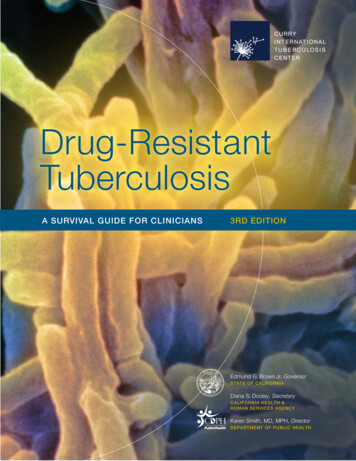
Transcription
Drug-ResistantTuberculosisA SURVIVAL GUIDE FOR CLINICIANS3RD EDITIONEdmund G. Brown Jr, GovernorSTATE OF CALIFORNIADiana S. Dooley, SecretaryCALIFORNIA HEALTH &HUMAN SERVICES AGENCYKaren Smith, MD, MPH, DirectorDEPARTMENT OF PUBLIC HEALTH
Drug-ResistantTuberculosisA SURVIVAL GUIDE FOR CLINICIANS3RD EDITIONEdmund G. Brown Jr, GovernorSTATE OF CALIFORNIADiana S. Dooley, SecretaryCALIFORNIA HEALTH &HUMAN SERVICES AGENCYKaren Smith, MD, MPH, DirectorDEPARTMENT OF PUBLIC HEALTH
Drug-Resistant Tuberculosis: A Survival Guide for Clinicians, Third Edition was createdthrough a collaboration of the Curry International Tuberculosis Center (CITC) and theState of California Department of Public Health, Tuberculosis Control Branch (CDPH).CITC is a project of the University of California, San Francisco, funded by the Centers forDisease Control and Prevention (CDC). The development of the third edition of this Guidewas funded through CDC Cooperative Agreement 1U52/PS004088-01. The viewsexpressed in written materials or publications do not necessarily reflect the official policiesof the Department of Health and Human Services, nor does the mention of trade names,commercial practices, or organizations imply endorsement by the U.S. Government.Permission is granted for nonprofit educational use and library duplication and distribution.Second printing. Correction made to Chapter 6, Pediatrics, Page 163, PediatricDrug Dosing, Table 4, Pyrazinamide.Online update:June 7, 2016October 25, 2016Suggested citation:Curry International Tuberculosis Center and California Department of Public Health,2016: Drug-Resistant Tuberculosis: A Survival Guide for Clinicians, Third Edition [inclusive page numbers].This publication is available on the Curry International Tuberculosis Center ans-3rd-editionDesign: Edi Berton Design
3rd Edition ContributorsPennan M. Barry, MD, MPHAnn M. Loeffler, MDChief, Surveillance and Epidemiology SectionTuberculosis Control BranchDivision of Communicable Disease ControlCenter for Infectious DiseasesCalifornia Department of Public Health, Richmond, CaliforniaPediatric Infectious Diseases and Inpatient MedicineRandall Children’s Hospital at Legacy Emanuel, Portland, OregonPediatric Tuberculosis ConsultantCurry International Tuberculosis Center, Oakland, CaliforniaLisa Pascopella, PhD, MPHAdithya Cattamanchi, MD, MASSenior Epidemiologist, Tuberculosis Control BranchDivision of Communicable Disease ControlCenter for Infectious DiseasesCalifornia Department of Public Health, Richmond, CaliforniaAssociate Professor of MedicineDivision of Pulmonary and Critical Care MedicineDepartment of MedicineSan Francisco General Hospital/University of California,San FranciscoCharles A. Peloquin, PharmDProfessor, and DirectorInfectious Disease Pharmacokinetics LaboratoryCollege of Pharmacy, and Emerging Pathogens InstituteUniversity of Florida, Gainesville, FloridaLisa Chen, MDPrincipal Investigator/Medical DirectorCurry International Tuberculosis Center, Oakland, CaliforniaProfessor, Division of Pulmonary and Critical Care MedicineUniversity of California, San FranciscoAnn M. Raftery, RN, PHN, MSAssociate Medical DirectorCurry International Tuberculosis CenterUniversity of California, San Francisco, Oakland, CaliforniaAmit S. Chitnis, MD, MPHPublic Health Medical Officer, Tuberculosis Control BranchDivision of Communicable Disease ControlCenter for Infectious DiseasesCalifornia Department of Public Health, Richmond, CaliforniaRandall E. Reves, MD, MScProfessorDivision of Infectious Diseases, Department of MedicineUniversity of Colorado Denver School of MedicineDenver, ColoradoCharles L. Daley, MDChiefDivision of Mycobacterial and Respiratory InfectionsNational Jewish HealthDenver, ColoradoGisela F. Schecter, MD, MPHConsultant, MDR-TB ServiceTuberculosis Control BranchDivision of Communicable Disease ControlCenter for Infectious DiseasesCalifornia Department of Public Health, Richmond, CaliforniaJennifer M. Flood, MD, MPHChief, Tuberculosis Control BranchDivision of Communicable Disease ControlCenter for Infectious DiseasesCalifornia Department of Public Health, Richmond, CaliforniaBarbara J. Seaworth, MDMedical DirectorHeartland National Tuberculosis CenterSan Antonio, TexasUniversity of Texas Health Science Center at TylerDavid E. Griffith, MDAssistant Medical DirectorHeartland National Tuberculosis CenterSan Antonio, TexasUniversity of Texas Health Science Center at TylerLisa True, RN, MSMDR Nurse Coordinator/Program LiaisonTuberculosis Control BranchDivision of Communicable Disease ControlCenter for Infectious DiseasesCalifornia Department of Public Health, Richmond, CaliforniaShou-Yean Grace Lin, MSResearch ScientistMicrobial Diseases LaboratoryCalifornia Department of Public Health, Richmond, CaliforniaEditorsEditorial BoardProject ManagerLisa Chen, MDGisela F. Schecter, MD, MPHCharles L. Daley, MDJennifer M. Flood, MD, MPHAnn M. Loeffler, MDKay Wallis, MPHDRUG-RESISTANT TUBERCULOSIS:i:Curry International Tuberculosis CenterUniversity of California, San FranciscoOakland, CaliforniaA SURVIVAL GUIDE FOR CLINICIANS : 3RD EDITION
Peer ReviewersDavid Ashkin, MDErica Lessem, MPHSoutheastern National Tuberculosis CenterUniversity of FloridaGainesville, FloridaTuberculosis/HIV ProjectTreatment Action GroupNew York City, New YorkHeidi Behm, RN, MPHShou-Yean Grace Lin, MSTuberculosis Program, Center for Public Health PracticeOregon Health AuthorityPortland, OregonMicrobial Diseases LaboratoryCalifornia Department of Public HealthRichmond, CaliforniaWilliam Burman, MDJulie E. Low, MDDenver Public HealthDenver HealthDenver, ColoradoPulmonary Disease ServicesOrange County Health Care AgencySanta Ana, CaliforniaAdithya Cattamanchi, MD, MASSundari Mase, MD, MPHDivision of Pulmonary and Critical Care MedicineDepartment of MedicineSan Francisco General Hospital/University of California,San FranciscoSan Francisco, CaliforniaField Services and Evaluation Branch, Division of TB EliminationNational Center for HIV, Hepatitis, STD and TB PreventionCenters for Disease Control and Prevention, Atlanta, GeorgiaLeona Mason, FNP, MPHInpatient Tuberculosis Unit, Infectious Diseases DivisionOlive View - UCLA Medical CenterSylmar, CaliforniaPeter Cegielski, MD, MPHInternational Research and Programs BranchDivision of TB EliminationNational Center for HIV, Hepatitis, STD and TB PreventionCenters for Disease Control and Prevention, Atlanta, GeorgiaBeverly Metchock, DrPHLaboratory Branch, Division of TB EliminationNational Center for HIV, Hepatitis, STD and TB PreventionCenters for Disease Control and Prevention, Atlanta, GeorgiaAmit S. Chitnis, MD, MPHTuberculosis Control BranchDivision of Communicable Disease ControlCenter for Infectious DiseasesCalifornia Department of Public Health, Richmond, CaliforniaKathleen Moser, MD, MPHTuberculosis Control ProgramSan Diego County Health and Human Services AgencySan Diego, CaliforniaDeliana Garcia, MAPayam Nahid, MD, MPHInternational Research and DevelopmentMigrant Clinicians NetworkAustin, TexasDivision of Pulmonary and Critical Care MedicineDepartment of MedicineUniversity of California, San FranciscoSan Francisco, CaliforniaJulie M. Higashi, MD, PhDTuberculosis Prevention and Control ProgramSan Francisco Department of Public HealthSan Francisco, CaliforniaMasahiro Narita, MDTuberculosis Control Program, Public Health –Seattle & King CountyDivision of Pulmonary & Critical Care, University of WashingtonSeattle, WashingtonJillian Hopewell, MPA, MAEducation and Professional DevelopmentMigrant Clinicians NetworkChico, CaliforniaDiana M. Nilsen, MD, RNBureau of Tuberculosis ControlNew York City Department of Health & Mental HygieneNew York City, New YorkC. Robert Horsburgh, Jr., MD, MUSDepartment of Epidemiology, School of Public HealthDepartment of Medicine, School of Medicine—Boston UniversityBoston, MassachusettsLisa Pascopella, PhD, MPHTuberculosis Control BranchDivision of Communicable Disease ControlCenter for Infectious Diseases,California Department of Public HealthRichmond, CaliforniaAlfred A. Lardizabal, MDNew Jersey Medical School Global Tuberculosis Institute at RutgersThe State University of New JerseyNewark, New JerseyDRUG-RESISTANT TUBERCULOSIS:ii:A SURVIVAL GUIDE FOR CLINICIANS : 3RD EDITION
Ann M. Raftery, RN, PHN, MSStephanie S. Spencer, MACurry International Tuberculosis CenterUniversity of California, San FranciscoOakland, CaliforniaTuberculosis Control Branch,Division of Communicable Disease ControlCenter for Infectious Diseases,California Department of Public HealthRichmond, CaliforniaCaitlin Reed, MD, MPHInpatient Tuberculosis Unit, Infectious Diseases DivisionOlive View-UCLA Medical CenterSylmar, CaliforniaJeffrey R. Starke, MDChildren’s Tuberculosis ClinicTexas Children’s HospitalHouston, TexasMax Salfinger, MDMycobacteriology and PharmacokineticsNational Jewish HealthDenver, ColoradoPennan M. Barry, MD, MPHLeslie Henry, BSN, PHNAlexander Kay, MDGayle Schack, RN, PHN, MSLisa True, RN, MSBarbara J. Seaworth, MDHeartland National Tuberculosis CenterSan Antonio, TexasUniversity of Texas Health Science Center at TylerMDR-TB Service, Tuberculosis Control BranchDivision of Communicable Disease ControlCenter for Infectious DiseasesCalifornia Department of Public HealthRichmond, CaliforniaNeha S. Shah, MD, MPHTuberculosis Control BranchCalifornia Department of Public HealthCenters for Disease Control and PreventionRichmond, CaliforniaAcknowledgementsSpecial appreciation is extended to the members of the MDR-TB Service of the Tuberculosis Control Branchat the California Department of Public Health (CDPH). Their systematic approach to providing expert consultation on cases of drug-resistant TB in California provided the initial inspiration to produce this Guide, and their sharedexpertise is reflected in its pages. The editorial board also thanks James Watt, MD, MPH, Chief of the Division ofCommunicable Disease Control, CDPH, for his leadership and support.Many individuals were involved in the writing, editing, research, and review of two previous editions of Drug-ResistantTuberculosis: A Survival Guide for Clinicians. The editors and editorial board of this third edition gratefully acknowledge the ongoing legacy of their contributions.We would also like to acknowledge: Jennifer J. Furin, MD, PhD, Case Western Reserve University and the SentinelProject (Chapter 6); and Ellen Murray, RN, BSN, Southeastern National Tuberculosis Center (Chapter 8), for sharing their specific expertise.DRUG-RESISTANT TUBERCULOSIS:iii:A SURVIVAL GUIDE FOR CLINICIANS : 3RD EDITION
Table of ContentsINTRODUCTION. . . . . . . . . . . . . . . . . . . . . . . . . . . . . . . . . . . . . . . . . . . . . . . . . . ixACRONYMS AND ABBREVIATIONS . . . . . . . . . . . . . . . . . . . . . . . . . . . . . . . . xiii1. EPIDEMIOLOGY AND BACKGROUND . . . . . . . . . . . . . . . . . . . . . . . . . . . . . 1Definitions. . . . . . . . . . . . . . . . . . . . . . . . . . . . . . . . . . . . . . . . . . . . . . . . . . . . . 2Drug-resistant TB across the globe . . . . . . . . . . . . . . . . . . . . . . . . . . . . . . . . . . 2Drug-resistant TB in the United States . . . . . . . . . . . . . . . . . . . . . . . . . . . . . . . 3Sources of drug-resistant TB in the United States. . . . . . . . . . . . . . . . . . . . . . . 7How is drug resistance generated? . . . . . . . . . . . . . . . . . . . . . . . . . . . . . . . . . 8References . . . . . . . . . . . . . . . . . . . . . . . . . . . . . . . . . . . . . . . . . . . . . . . . . . . 112. DIAGNOSIS. . . . . . . . . . . . . . . . . . . . . . . . . . . . . . . . . . . . . . . . . . . . . . . . . . . 13Risk assessment for drug resistance . . . . . . . . . . . . . . . . . . . . . . . . . . . . . . . .In persons with a history of prior TB. . . . . . . . . . . . . . . . . . . . . . . . . . . . . . .In persons without prior TB history. . . . . . . . . . . . . . . . . . . . . . . . . . . . . . . .Questions to ask your patient . . . . . . . . . . . . . . . . . . . . . . . . . . . . . . . . . . .Testing for TB infection . . . . . . . . . . . . . . . . . . . . . . . . . . . . . . . . . . . . . . . . . .Testing for TB disease. . . . . . . . . . . . . . . . . . . . . . . . . . . . . . . . . . . . . . . . . . .Molecular assays . . . . . . . . . . . . . . . . . . . . . . . . . . . . . . . . . . . . . . . . . . . .Testing for drug resistance . . . . . . . . . . . . . . . . . . . . . . . . . . . . . . . . . . . . . . .Molecular assays (Xpert MTB/RIF) . . . . . . . . . . . . . . . . . . . . . . . . . . . . . . . .When to use rapid molecular tests for drug resistance . . . . . . . . . . . . . . . . .Communication with the TB laboratory . . . . . . . . . . . . . . . . . . . . . . . . . . . . . .When to order second-line drug testing. . . . . . . . . . . . . . . . . . . . . . . . . . . . . .False-positive results. . . . . . . . . . . . . . . . . . . . . . . . . . . . . . . . . . . . . . . . . . . .Discordant results . . . . . . . . . . . . . . . . . . . . . . . . . . . . . . . . . . . . . . . . . . . . . .Use of strain typing . . . . . . . . . . . . . . . . . . . . . . . . . . . . . . . . . . . . . . . . . . . . .Resources and references. . . . . . . . . . . . . . . . . . . . . . . . . . . . . . . . . . . . . . . .151515161818181920212323242527283. LABORATORY. . . . . . . . . . . . . . . . . . . . . . . . . . . . . . . . . . . . . . . . . . . . . . . . . 31General information on TB laboratory work . . . . . . . . . . . . . . . . . . . . . . . . . . . 32Communication between clinician and laboratory . . . . . . . . . . . . . . . . . . . . . 34How should specimens be collected for smear and culture?. . . . . . . . . . . . . 35Microscopy, culture identification, and growth-based testing. . . . . . . . . . . . . . 36AFB smear . . . . . . . . . . . . . . . . . . . . . . . . . . . . . . . . . . . . . . . . . . . . . . . . 36Culture identification . . . . . . . . . . . . . . . . . . . . . . . . . . . . . . . . . . . . . . . . . . 36Conventional growth-based drug susceptibility testing (DST). . . . . . . . . . . . . 37Critical concentration and minimum inhibitory concentration (MIC) . . . . . . . . . 41Molecular methods for detection of M. tuberculosis complex and drug resistance. . 44Molecular detection of M. tuberculosis complex . . . . . . . . . . . . . . . . . . . . . . 44Genes associated with drug resistance . . . . . . . . . . . . . . . . . . . . . . . . . . . . 45Molecular tests for drug resistance . . . . . . . . . . . . . . . . . . . . . . . . . . . . . . . 48 Probe-based tests(Molecular beacon assay: Xpert MTB/RIF; Line-probe assays). . . . . . . . 49 Sequence-based tests . . . . . . . . . . . . . . . . . . . . . . . . . . . . . . . . . . . . 51 Choice of molecular tests . . . . . . . . . . . . . . . . . . . . . . . . . . . . . . . . . . 52 Difficulties interpreting results from molecular tests . . . . . . . . . . . . . . . . 52DRUG-RESISTANT TUBERCULOSIS:iv:A SURVIVAL GUIDE FOR CLINICIANS : 3RD EDITION
Molecular tests on extrapulmonary specimens . . . . . . . . . . . . . . . . . . . Molecular tests on formalin-fixed specimens. . . . . . . . . . . . . . . . . . . . .Therapeutic drug monitoring (TDM) . . . . . . . . . . . . . . . . . . . . . . . . . . . . . . . . .National TB genotyping service. . . . . . . . . . . . . . . . . . . . . . . . . . . . . . . . . . . .References . . . . . . . . . . . . . . . . . . . . . . . . . . . . . . . . . . . . . . . . . . . . . . . . . . .54555659614. TREATMENT. . . . . . . . . . . . . . . . . . . . . . . . . . . . . . . . . . . . . . . . . . . . . . . . . . 63Consultation with experts . . . . . . . . . . . . . . . . . . . . . . . . . . . . . . . . . . . . . . . . 64Classification of anti-tuberculosis drugs. . . . . . . . . . . . . . . . . . . . . . . . . . . . . . 65Starting an expanded empiric treatment regimen. . . . . . . . . . . . . . . . . . . . . . . 66Individualized treatment regimens. . . . . . . . . . . . . . . . . . . . . . . . . . . . . . . . . . 67Mono-resistant M. tuberculosis . . . . . . . . . . . . . . . . . . . . . . . . . . . . . . . . . . 67Poly-resistant M. tuberculosis . . . . . . . . . . . . . . . . . . . . . . . . . . . . . . . . . . . 69Multidrug-resistant M. tuberculosis (MDR-TB). . . . . . . . . . . . . . . . . . . . . . . . 71Duration of therapy. . . . . . . . . . . . . . . . . . . . . . . . . . . . . . . . . . . . . . . . . . . 73Selection and dosing of individual drugs: Additional considerations . . . . . . . . 75Cross-resistance . . . . . . . . . . . . . . . . . . . . . . . . . . . . . . . . . . . . . . . . . . . . 75Avoid drugs used previously . . . . . . . . . . . . . . . . . . . . . . . . . . . . . . . . . . . . 75Consider side effects . . . . . . . . . . . . . . . . . . . . . . . . . . . . . . . . . . . . . . . . . 75Individual regimens for specific MDR-TB resistance patterns. . . . . . . . . . . . . . 77Extensively drug-resistant M. tuberculosis (XDR-TB) . . . . . . . . . . . . . . . . . . . . 79Specific drugs. . . . . . . . . . . . . . . . . . . . . . . . . . . . . . . . . . . . . . . . . . . . . . . . . 81First-line. . . . . . . . . . . . . . . . . . . . . . . . . . . . . . . . . . . . . . . . . . . . . . . . . . . 81Second-line. . . . . . . . . . . . . . . . . . . . . . . . . . . . . . . . . . . . . . . . . . . . . . . . 82Third-line . . . . . . . . . . . . . . . . . . . . . . . . . . . . . . . . . . . . . . . . . . . . . . . . . . 85New drugs: BDQ, DLM. . . . . . . . . . . . . . . . . . . . . . . . . . . . . . . . . . . . . . . . 86Administration of the treatment regimen . . . . . . . . . . . . . . . . . . . . . . . . . . . . . 88Escalation of dosages (drug ramping). . . . . . . . . . . . . . . . . . . . . . . . . . . . . . 88Therapeutic drug monitoring (TDM) . . . . . . . . . . . . . . . . . . . . . . . . . . . . . . . . . 89Role of surgery . . . . . . . . . . . . . . . . . . . . . . . . . . . . . . . . . . . . . . . . . . . . . . . . 91Outcomes of treatment . . . . . . . . . . . . . . . . . . . . . . . . . . . . . . . . . . . . . . . . . . 92References . . . . . . . . . . . . . . . . . . . . . . . . . . . . . . . . . . . . . . . . . . . . . . . . . . . 935. MEDICATION FACT SHEETS . . . . . . . . . . . . . . . . . . . . . . . . . . . . . . . . . . . . 99Amikacin. . . . . . . . . . . . . . . . . . . . .Amoxicillin/clavulanate. . . . . . . . . .Bedaquiline. . . . . . . . . . . . . . . . . . .Capreomycin . . . . . . . . . . . . . . . . .Clarithromycin . . . . . . . . . . . . . . . .Clofazimine. . . . . . . . . . . . . . . . . . .Cycloserine. . . . . . . . . . . . . . . . . . .Delamanid. . . . . . . . . . . . . . . . . . . .Ethambutol. . . . . . . . . . . . . . . . . . .Ethionamide . . . . . . . . . . . . . . . . . .Imipenem/Cilastatin . . . . . . . . . . . .Isoniazid. . . . . . . . . . . . . . . . . . . . .Kanamycin . . . . . . . . . . . . . . . . . . .DRUG-RESISTANT TUBERCULOSISLevofloxacin. . . . . . . . . . . . . . . . . .Linezolid. . . . . . . . . . . . . . . . . . . . .Meropenem . . . . . . . . . . . . . . . . . .Moxifloxacin. . . . . . . . . . . . . . . . . .Para-aminosalicylate . . . . . . . . . . .Pyrazinamide . . . . . . . . . . . . . . . . .Rifabutin. . . . . . . . . . . . . . . . . . . . .Rifampin. . . . . . . . . . . . . . . . . . . . .Rifapentine. . . . . . . . . . . . . . . . . . .Streptomycin . . . . . . . . . . . . . . . . .New anti-TB drugs in the pipeline. .References. . . . . . . . . . . . . . . . . . 30132134136138140142144146147A SURVIVAL GUIDE FOR CLINICIANS : 3RD EDITION
6. PEDIATRICS . . . . . . . . . . . . . . . . . . . . . . . . . . . . . . . . . . . . . . . . . . . . . . . . . 149Magnitude of the pediatric drug-resistant TB burden. . . . . . . . . . . . . . . . . . .Collection of pediatric specimens . . . . . . . . . . . . . . . . . . . . . . . . . . . . . . . . .Gastric aspirates. . . . . . . . . . . . . . . . . . . . . . . . . . . . . . . . . . . . . . . . . . . .Sputum collection. . . . . . . . . . . . . . . . . . . . . . . . . . . . . . . . . . . . . . . . . . .Molecular and microbiologic techniques . . . . . . . . . . . . . . . . . . . . . . . . . . . .Treatment of drug-resistant TB . . . . . . . . . . . . . . . . . . . . . . . . . . . . . . . . . . .General principles. . . . . . . . . . . . . . . . . . . . . . . . . . . . . . . . . . . . . . . . . . .Administering oral TB drugs. . . . . . . . . . . . . . . . . . . . . . . . . . . . . . . . . . . .TB drug dosages . . . . . . . . . . . . . . . . . . . . . . . . . . . . . . . . . . . . . . . . . . .Specific TB drugs. . . . . . . . . . . . . . . . . . . . . . . . . . . . . . . . . . . . . . . . . . .Tables: Pediatric drug dosing . . . . . . . . . . . . . . . . . . . . . . . . . . . . . . . . . .When to start a regimen . . . . . . . . . . . . . . . . . . . . . . . . . . . . . . . . . . . . . .Treatment of drug-resistant LTBI. . . . . . . . . . . . . . . . . . . . . . . . . . . . . . . . . .TST or IGRA? . . . . . . . . . . . . . . . . . . . . . . . . . . . . . . . . . . . . . . . . . . . . .Treatment options for MDR-LTBI . . . . . . . . . . . . . . . . . . . . . . . . . . . . . . . .Window prophylaxis . . . . . . . . . . . . . . . . . . . . . . . . . . . . . . . . . . . . . . . . .Monitoring . . . . . . . . . . . . . . . . . . . . . . . . . . . . . . . . . . . . . . . . . . . . . . . .Resources and References . . . . . . . . . . . . . . . . . . . . . . . . . . . . . . . . . . . . . 691717. CO-MORBIDITIES AND SPECIAL SITUATIONS. . . . . . . . . . . . . . . . . . . . 173Extrapulmonary TB . . . . . . . . . . . . . . . . . . . . . . . . . . . . . . . . . . . . . . . . . . . .Central nervous system (CNS). . . . . . . . . . . . . . . . . . . . . . . . . . . . . . . . . .HIV . . . . . . . . . . . . . . . . . . . . . . . . . . . . . . . . . . . . . . . . . . . . . . . . . . . . . . . .Diabetes mellitus. . . . . . . . . . . . . . . . . . . . . . . . . . . . . . . . . . . . . . . . . . . . . .Liver disease. . . . . . . . . . . . . . . . . . . . . . . . . . . . . . . . . . . . . . . . . . . . . . . . .Renal failure. . . . . . . . . . . . . . . . . . . . . . . . . . . . . . . . . . . . . . . . . . . . . . . . . .Pregnancy. . . . . . . . . . . . . . . . . . . . . . . . . . . . . . . . . . . . . . . . . . . . . . . . . . .Teratogenicity. . . . . . . . . . . . . . . . . . . . . . . . . . . . . . . . . . . . . . . . . . . . . .Infection control . . . . . . . . . . . . . . . . . . . . . . . . . . . . . . . . . . . . . . . . . . . .Management of the newborn. . . . . . . . . . . . . . . . . . . . . . . . . . . . . . . . . . .Solid organ transplant . . . . . . . . . . . . . . . . . . . . . . . . . . . . . . . . . . . . . . . . . .Resources and references. . . . . . . . . . . . . . . . . . . . . . . . . . . . . . . . . . . . . . .1741751771801821831871881881891911938. MONITORING AND CASE MANAGEMENT. . . . . . . . . . . . . . . . . . . . . . . . 197Case management of MDR-TB . . . . . . . . . . . . . . . . . . . . . . . . . . . . . . . . . . .Roles and responsibilities . . . . . . . . . . . . . . . . . . . . . . . . . . . . . . . . . . . . . . .Initiating treatment. . . . . . . . . . . . . . . . . . . . . . . . . . . . . . . . . . . . . . . . . . . . .Initial evaluation. . . . . . . . . . . . . . . . . . . . . . . . . . . . . . . . . . . . . . . . . . . . .Use of case management tools. . . . . . . . . . . . . . . . . . . . . . . . . . . . . . . . .Monitoring throughout treatment. . . . . . . . . . . . . . . . . . . . . . . . . . . . . . . . . .Monitoring treatment response . . . . . . . . . . . . . . . . . . . . . . . . . . . . . . . . .Assessment for treatment failure . . . . . . . . . . . . . . . . . . . . . . . . . . . . . . . .Monitoring for drug toxicity . . . . . . . . . . . . . . . . . . . . . . . . . . . . . . . . . . . .Monitoring tools and strategies . . . . . . . . . . . . . . . . . . . . . . . . . . . . . . . . .Post-treatment monitoring . . . . . . . . . . . . . . . . . . . . . . . . . . . . . . . . . . . . . .DRUG-RESISTANT TUBERCULOSIS:vi:198198200200202203203208209212212A SURVIVAL GUIDE FOR CLINICIANS : 3RD EDITION
Patient-centered care and ensuring adherence . . . . . . . . . . . . . . . . . . . . . . . 212Directly observed therapy . . . . . . . . . . . . . . . . . . . . . . . . . . . . . . . . . . . . . 214Providing the injectable agent . . . . . . . . . . . . . . . . . . . . . . . . . . . . . . . . . . 215Patient education . . . . . . . . . . . . . . . . . . . . . . . . . . . . . . . . . . . . . . . . . . . 217Psychosocial support . . . . . . . . . . . . . . . . . . . . . . . . . . . . . . . . . . . . . . . . 219Economic support . . . . . . . . . . . . . . . . . . . . . . . . . . . . . . . . . . . . . . . . . . 221Use of legal orders. . . . . . . . . . . . . . . . . . . . . . . . . . . . . . . . . . . . . . . . . . 224Continuity of care . . . . . . . . . . . . . . . . . . . . . . . . . . . . . . . . . . . . . . . . . . . . . 225Hospitalization and discharge planning. . . .
Jun 07, 2016 · Drug-Resistant Tuberculosis: A Survival Guide for Clinicians, Third Edition was created through a collaboration of the Curry International Tuberculosis Center (CITC) and the State of California Departm
